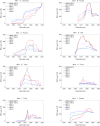Reanalysis of the DEMS nested case-control study of lung cancer and diesel exhaust: suitability for quantitative risk assessment
- PMID: 25857246
- PMCID: PMC4690516
- DOI: 10.1111/risa.12371
Reanalysis of the DEMS nested case-control study of lung cancer and diesel exhaust: suitability for quantitative risk assessment
Abstract
The International Agency for Research on Cancer (IARC) in 2012 upgraded its hazard characterization of diesel engine exhaust (DEE) to "carcinogenic to humans." The Diesel Exhaust in Miners Study (DEMS) cohort and nested case-control studies of lung cancer mortality in eight U.S. nonmetal mines were influential in IARC's determination. We conducted a reanalysis of the DEMS case-control data to evaluate its suitability for quantitative risk assessment (QRA). Our reanalysis used conditional logistic regression and adjusted for cigarette smoking in a manner similar to the original DEMS analysis. However, we included additional estimates of DEE exposure and adjustment for radon exposure. In addition to applying three DEE exposure estimates developed by DEMS, we applied six alternative estimates. Without adjusting for radon, our results were similar to those in the original DEMS analysis: all but one of the nine DEE exposure estimates showed evidence of an association between DEE exposure and lung cancer mortality, with trend slopes differing only by about a factor of two. When exposure to radon was adjusted, the evidence for a DEE effect was greatly diminished, but was still present in some analyses that utilized the three original DEMS DEE exposure estimates. A DEE effect was not observed when the six alternative DEE exposure estimates were utilized and radon was adjusted. No consistent evidence of a DEE effect was found among miners who worked only underground. This article highlights some issues that should be addressed in any use of the DEMS data in developing a QRA for DEE.
Keywords: Diesel engine exhaust; lung cancer; nonmetal mines; risk assessment.
© 2015 Society for Risk Analysis.
Figures



Similar articles
-
Reanalysis of Diesel Engine Exhaust and Lung Cancer Mortality in the Diesel Exhaust in Miners Study Cohort Using Alternative Exposure Estimates and Radon Adjustment.Am J Epidemiol. 2018 Jun 1;187(6):1210-1219. doi: 10.1093/aje/kwy038. Am J Epidemiol. 2018. PMID: 29522073 Free PMC article.
-
Influence of Alternative Exposure Estimates in the Diesel Exhaust Miners Study: Diesel Exhaust and Lung Cancer.Risk Anal. 2016 Sep;36(9):1803-12. doi: 10.1111/risa.12556. Epub 2016 Feb 22. Risk Anal. 2016. PMID: 26905315
-
The impact of alternative historical extrapolations of diesel exhaust exposure and radon in the Diesel Exhaust in Miners Study (DEMS).Int J Epidemiol. 2020 Apr 1;49(2):459-466. doi: 10.1093/ije/dyz189. Int J Epidemiol. 2020. PMID: 31539056 Free PMC article.
-
A critical review of the relationship between occupational exposure to diesel emissions and lung cancer risk.Crit Rev Toxicol. 2017 Mar;47(3):185-224. doi: 10.1080/10408444.2016.1266598. Epub 2017 Feb 9. Crit Rev Toxicol. 2017. PMID: 28322628 Review.
-
Evaluation of an exposure assessment used in epidemiological studies of diesel exhaust and lung cancer in underground mines.Crit Rev Toxicol. 2012 Aug;42(7):599-612. doi: 10.3109/10408444.2012.689755. Epub 2012 May 18. Crit Rev Toxicol. 2012. PMID: 22594934 Free PMC article. Review.
Cited by
-
THE AUTHOR REPLIES.Am J Epidemiol. 2019 Feb 1;188(2):491-492. doi: 10.1093/aje/kwy178. Am J Epidemiol. 2019. PMID: 30192912 Free PMC article. No abstract available.
-
Reanalysis of Diesel Engine Exhaust and Lung Cancer Mortality in the Diesel Exhaust in Miners Study Cohort Using Alternative Exposure Estimates and Radon Adjustment.Am J Epidemiol. 2018 Jun 1;187(6):1210-1219. doi: 10.1093/aje/kwy038. Am J Epidemiol. 2018. PMID: 29522073 Free PMC article.
-
Diesel engine exhaust and lung cancer risks - evaluation of the meta-analysis by Vermeulen et al. 2014.J Occup Med Toxicol. 2015 Aug 12;10:31. doi: 10.1186/s12995-015-0073-6. eCollection 2015. J Occup Med Toxicol. 2015. PMID: 26269706 Free PMC article.
-
Invited Perspective: Diesel Exhaust and Lung Cancer-Delayed Findings Confirmed, but Consequences Continue.Environ Health Perspect. 2023 Aug;131(8):81301. doi: 10.1289/EHP13258. Epub 2023 Aug 7. Environ Health Perspect. 2023. PMID: 37549096 Free PMC article. No abstract available.
-
Challenges and Opportunities for Occupational Epidemiology in the Twenty-first Century.Curr Environ Health Rep. 2017 Sep;4(3):319-324. doi: 10.1007/s40572-017-0154-z. Curr Environ Health Rep. 2017. PMID: 28803393 Review.
References
-
- McClellan RO. Health effects of diesel exhaust: A case study in risk assessment. American Industrial Hygiene Association Journal. 1986;47:1–13. - PubMed
-
- McClellan RO. Health effects of exposure to diesel exhaust. Annual Review of Pharmacology and Toxicology. 1987;27:279–300. - PubMed
-
- Health Effects Institute. A Special Report of the Institute’s Diesel Epidemiology Expert Panel. Cambridge, MA: Health Effects Institute; 1999. Diesel Emissions and Lung Cancer: Epidemiology and Quantitative Risk Assessment.
Publication types
MeSH terms
Substances
LinkOut - more resources
Full Text Sources
Other Literature Sources
Medical

